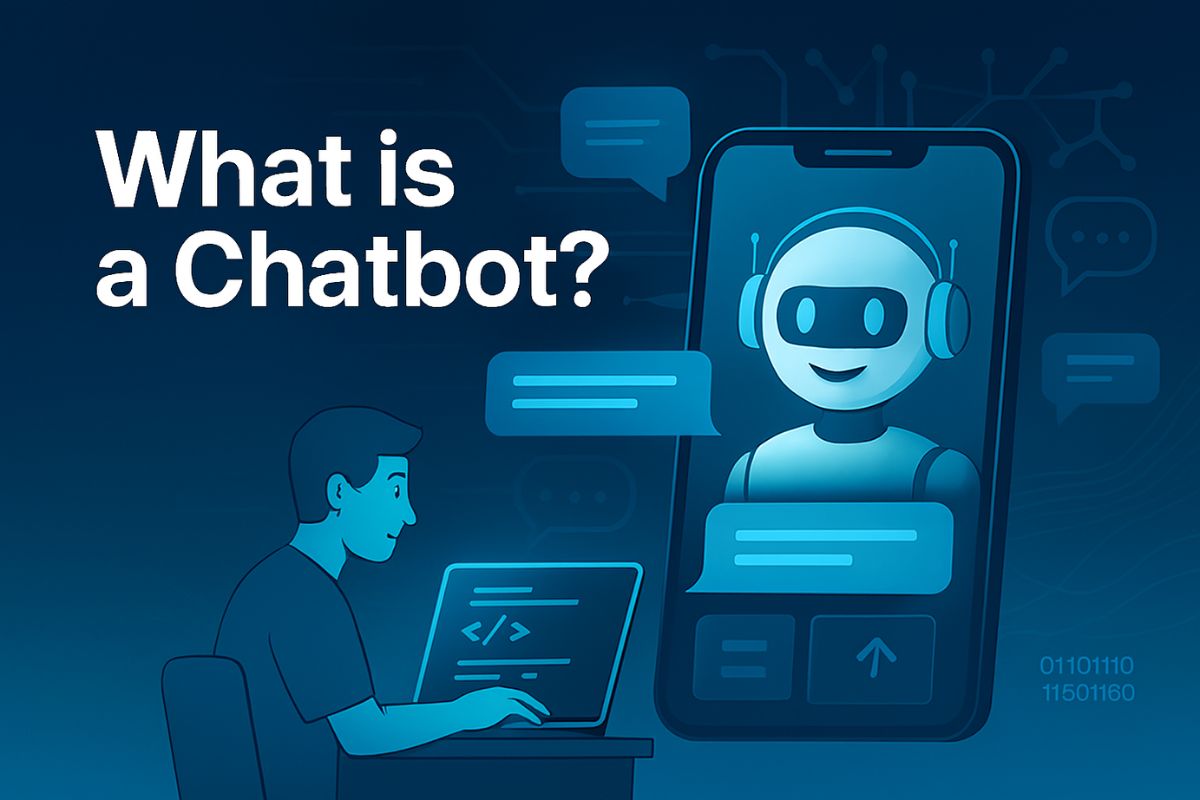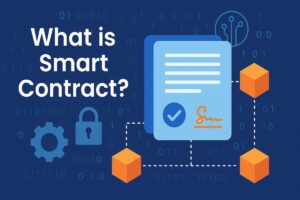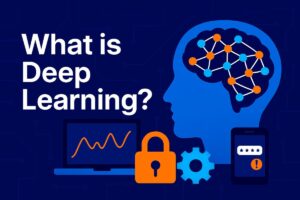A chatbot is an AI-powered program designed to simulate human conversations. Used in customer service, education, healthcare, and business, chatbots automate interactions, reduce costs, and provide 24/7 support. In this guide, you’ll learn what chatbots are, how they work, different types, benefits, real-life examples, and future trends.
From answering customer queries to helping you book a flight, chatbots have become a regular part of our digital lives.
But what exactly is a chatbot? How do they work? And why are businesses investing heavily in chatbot technology?
In this blog, we’ll break it all down—from the basics to real-world use cases—so you can understand how chatbots are transforming the way we interact with technology.
What is a Chatbot?
A chatbot is a computer program or software application that simulates human conversation through voice or text interactions. Chatbots are often used in messaging apps, websites, and virtual assistants to respond automatically to user questions or requests.
In simple terms, a chatbot acts as a digital assistant that understands language and provides quick, relevant answers.
Brief History of Chatbots
- 1966 – ELIZA: The first chatbot, developed at MIT, mimicked a psychotherapist.
- 1995 – ALICE: Used pattern-matching to generate human-like responses.
- 2011 – Siri: Apple’s voice-based assistant ushered in a new wave of AI-powered bots.
- 2016 – Facebook Messenger Bots: Businesses started deploying chatbots for marketing and support.
- 2022–Present – ChatGPT & Bard: Large Language Models (LLMs) took chatbot technology to new levels.
How Do Chatbots Work?
The functionality of chatbots depends on their type—either rule-based or AI-powered.
Rule-Based vs AI-Powered Chatbots
| Type | How It Works | Best Use Case |
|---|---|---|
| Rule-Based Bot | Follows pre-defined decision trees | FAQs, appointment scheduling |
| AI Chatbot | Uses machine learning and NLP | Personalized conversations, sales |
Natural Language Processing (NLP)
NLP allows chatbots to:
- Understand human language (input)
- Interpret meaning (intent)
- Generate human-like responses (output)
This is how AI chatbots like ChatGPT can hold meaningful, context-aware conversations.
Chatbot Architecture & Components
- User Interface (UI): Where users interact (e.g., website chat window).
- NLU Engine: Natural Language Understanding (extracts intent and entities).
- Dialog Manager: Maintains the conversation state.
- Backend & APIs: Connects chatbot to databases, CRM, payment systems, etc.
Types of Chatbots
Chatbots come in different forms, each serving unique purposes.
1. Rule-Based Chatbots
- Work on predefined rules or decision trees.
- Can’t learn from past interactions.
- Ideal for simple tasks like menu navigation or yes/no responses.
2. AI-Powered Chatbots
- Use machine learning and NLP to evolve over time.
- Understand intent, context, and sentiment.
- Examples: ChatGPT, Google Bard, Watson Assistant.
3. Voice-Enabled Chatbots
- Use speech recognition and synthesis.
- Found in devices like Amazon Alexa, Google Assistant, and Siri.
- Enable hands-free interaction.
4. Hybrid Chatbots
- Combine rule-based and AI techniques.
- Can switch between scripted and free-form interactions.
- Common in customer service where both FAQs and personalized help are needed.
Benefits of Chatbots
Businesses and users both gain from chatbot adoption. Here’s how:
1. 24/7 Availability
Chatbots provide support anytime, reducing the need for human agents outside of working hours.
2. Cost Savings
Automating repetitive tasks reduces labor costs significantly.
3. Instant Response Time
Chatbots reply within milliseconds, improving user satisfaction.
4. Scalability
One chatbot can handle thousands of interactions at once.
5. Improved Customer Experience
Chatbots can guide users, offer solutions, and personalize responses based on data.
6. Multilingual Support
Advanced chatbots can communicate in multiple languages, making global support possible.
Real-Life Examples & Use Cases
E-Commerce & Retail
- Example: H&M’s chatbot helps users browse and buy clothes.
- Chatbots recommend products, process returns, and answer product queries.
Customer Support
- Example: Bank of America’s Erica helps users manage finances.
- Reduces call volumes and improves resolution times.
Healthcare
- Example: Babylon Health chatbot offers symptom checks and medical advice.
- Used for initial diagnosis and appointment booking.
Banking & Finance
- Example: ICICI Bank’s iPal bot helps with balance checks, statements, and service requests.
- Offers secure, fast banking via messaging.
Education
- Example: Duolingo’s chatbot practices foreign languages with learners.
- Enhances student engagement with personalized tutoring.
Travel & Hospitality
- Example: Expedia’s chatbot helps with flight search, booking, and reminders.
- Increases convenience and user satisfaction.
Common Challenges & Limitations
Misunderstanding Complex Queries
Chatbots may struggle with slang, sarcasm, or multi-part questions.
Data Privacy Concerns
Improper handling of personal data can lead to compliance issues (e.g., GDPR).
Limited Context Awareness
Some chatbots can’t remember past interactions, making conversations repetitive.
Over-Automation
Replacing too many human touchpoints can hurt user trust and satisfaction.
Future Trends in Chatbots
Chatbots are evolving rapidly thanks to advancements in AI, cloud computing, and voice tech.
1. Conversational AI
Chatbots will hold longer, more natural conversations using transformer models (like GPT).
2. Emotionally Aware Bots
AI will learn to detect user emotions and respond empathetically.
3. Integration with IoT
Chatbots will control smart devices—like adjusting your AC or switching on lights via voice.
4. Personalized AI Assistants
Future bots will remember preferences, habits, and even predict your needs.
5. Cross-Platform Functionality
Chatbots will seamlessly operate across WhatsApp, websites, apps, and voice assistants.
Expert Tips for Using Chatbots Effectively
- Define your chatbot’s goals clearly (e.g., support, lead gen, booking).
- Choose the right platform (Messenger, WhatsApp, website, or voice).
- Use analytics to monitor chatbot performance.
- Update FAQs regularly to ensure relevancy.
- Offer human fallback options for complex cases.
- Test the bot with real users before full deployment.
Conclusion
Chatbots have evolved from simple scripts into powerful AI-driven tools that improve customer service, automate workflows, and enhance user experience.
As technology advances, chatbots will become more natural, intuitive, and emotionally intelligent—making them an essential part of business operations and personal productivity.
Want to stay ahead of the AI curve? Follow Schoolication for more in-depth guides on AI, NLP, chatbots, and digital transformation.
FAQs
1. What is a chatbot?
A chatbot is a software application that simulates conversation with users using text or voice, often powered by AI.
2. How do chatbots work?
They analyze user input using NLP and respond based on pre-programmed logic or machine learning.
3. Are chatbots AI?
Not all. Some are rule-based, while others use AI to understand and learn from conversations.
4. What are some examples of chatbots?
ChatGPT, Alexa, Siri, Google Assistant, H&M chatbot, and Duolingo bots are popular examples.
5. Can chatbots replace humans?
No. They assist with repetitive tasks but still require human oversight for complex scenarios.
6. Are chatbots safe?
Yes, when implemented with proper data protection and security measures.
7. Which industries benefit most from chatbots?
Customer service, healthcare, banking, education, retail, and travel.



